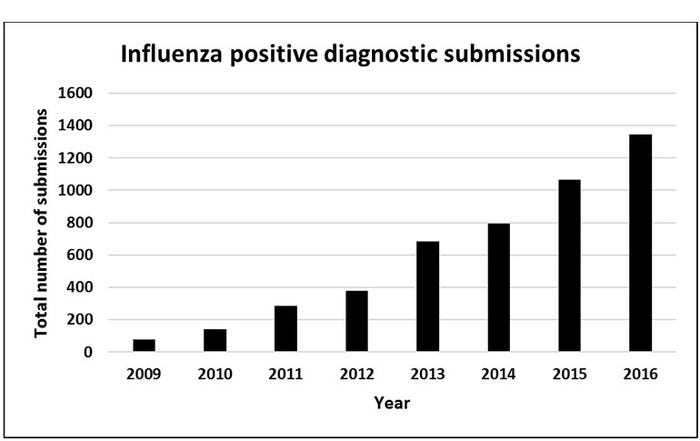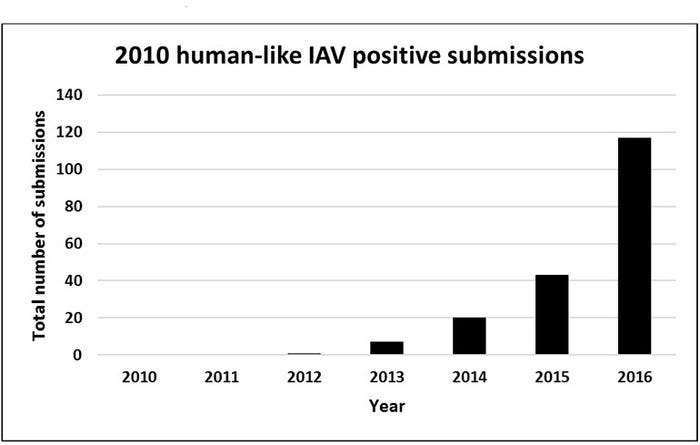Veterinarians and swine producers are encouraged to use diagnostic tests and genetic sequencing to monitor the presence and different strains of IAV circulating in their swine.
October 3, 2017

By Michael Zeller, Chris Rademacher and Phillip Gauger, Iowa State University Veterinary Diagnostic Laboratory Veterinary Diagnostic and Production Animal Medicine
Influenza A virus remains one of the top three respiratory diseases affecting swine in spite of efforts to control infection through vaccines and biosecurity methods. In fact, IAV positive cases submitted to the Iowa State University Veterinary Diagnostic Laboratory have been increasing since the pandemic H1N1 in 2009 (Figure 1).
Producers and veterinarians are well aware of the negative health and production impacts influenza can cause in swine. Elevated morbidity characterized by coughing, sneezing and anorexia is common, as well as increased mortality that may occur through secondary bacterial infections, which increase the time to market and production costs.
Unfortunately, influenza has become more difficult to control in swine production systems due to the emergence of genetically diverse strains that currently circulate in swine. This diversity is influenced by several factors. Random mutations in the virus genome, known as genetic drift, can affect the antigenic phenotype of that strain of IAV. In addition, genetic shift can occur when two different IAV exchange genetic material, a process called reassortment, and may result in the emergence of a unique IAV.
Mixing pigs from different sources and transporting pigs over long distances also supports transmission and the generation of novel influenza viruses. As a result, influenza vaccines struggle to provide adequate protection against all of the different IAV circulating in the swine population.

Figure 1: Number of Influenza A Virus positive diagnostic cases submitted to the Iowa State University Veterinary Diagnostic Laboratory
Influenza A virus in swine is an ubiquitous infection, meaning it is found in pigs throughout the world and is easily transmitted among swine even through long distances (Torremorell, Allerson, Corzo, Diaz and Gramer, 2012). Influenza is also a zoonotic disease in which swine influenza viruses can be transmitted to humans. However, human influenza viruses are also transmitted to swine, a process called reverse zoonosis. Although pigs are considered a mixing vessel for influenza viruses from different species, history has demonstrated that human influenza viruses have contributed to the genetic diversity currently recognized in swine.
Influenza was first introduced into pigs through a human virus during the 1918 H1N1 Spanish flu epidemic, where veterinarian J. S. Koen observed similar clinical signs between humans and swine. Although the H1N1 IAV, known more commonly as the “classical” H1N1, has become endemic in swine, it is interesting that the virus remained relatively stable and the only subtype consistently detected in North America until the mid-1990s.
The IAV picture changed in 1998 when a human H3N2 subtype spilled over from humans and quickly established itself as a new subtype in swine. After the emergence of the H3N2 in swine, subsequent reassortment with the classical H1N1 resulted in the three predominant subtypes currently circulating in swine — H1N1, H1N2 and H3N2. Additional human seasonal H1 influenza viruses infected pigs in the early 2000s and became established in swine and the 2009 human pandemic H1N1 was transmitted from infected people to pigs starting in 2010.
Human seasonal H3 viruses have also been transmitted to swine. The last sustained spillover that occurred was the 2011 human seasonal H3 strain that is now become the predominant genotype in swine (Figure 2). Another H3 human virus detected in pigs in 2016 is the latest spillover, but it is unknown if this human-like virus will persist in swine. Additional transmission of human influenza viruses into swine have occurred, but many go unnoticed and never become established. Each new strain of IAV introduced into pigs complicates our control strategies including vaccination. The fast rate of genetic mutations in the virus can evade current population or vaccine immunity requiring new or updated vaccines to provide adequate control.

Figure 2: Number of 2011 human-like H3 Influenza A Virus positive diagnostic cases detected at the Iowa State University Veterinary Diagnostic Laboratory
Interactions between farm employees infected with IAV and swine provides the necessary contact to allow transmission of human IAV to pigs. The risk of having swine infected with human-origin IAV reaches beyond the genetic diversity that typically results from these occurrences. As the virus circulates in swine, it increases the probability the virus could spill back over into humans. While it is a challenge, improved biosecurity can mitigate the impact humans have on swine health in regards to influenza. Basic practices such as employee sick-leave policies, especially if influenza-like symptoms are present, go a long way in prevention. Suggesting the use of the human influenza vaccines can also help reduce the level of infection in people through less viral shedding that can occur from humans to swine. In humans, IAV shedding peaks with the onset of clinical signs and can persist from five to seven days, even if the initial symptoms are not present. Protecting swine from human seasonal influenza viruses could decrease the rate of genetic change in the swine population and decrease the risk of zoonotic transmission from swine to humans. The challenge goes both ways and all involved should be responsible for their part in reducing the impact influenza has had on both pigs and people.
Veterinarians and swine producers are encouraged to use diagnostic tests and genetic sequencing to monitor the presence and different strains of IAV circulating in their swine. This knowledge is necessary to develop appropriate and successful vaccination and biosecurity methods to help prevent the clinical effects of influenza in their swine production systems. The ISU VDL has a new website known as “ISU FLUture” that is publically available and provides multiple interactive tools to view the ISU VDL influenza data in charts and graphs. This website is useful to track trends in the influenza diagnostic data, view changes in the frequency of detection of different H1 and H3 clades, and evaluate changes in the diagnostic results over time. The website is also a great resource to view new IAV that may have emerged in the swine population and help direct decisions regarding the control of IAV when necessary.
Torremorell, M., Allerson, M., Corzo, C., Diaz, A. and Gramer, M. (2012). Transmission of Influenza A Virus in Pigs. Transbound. Emerg Dis.
You May Also Like



